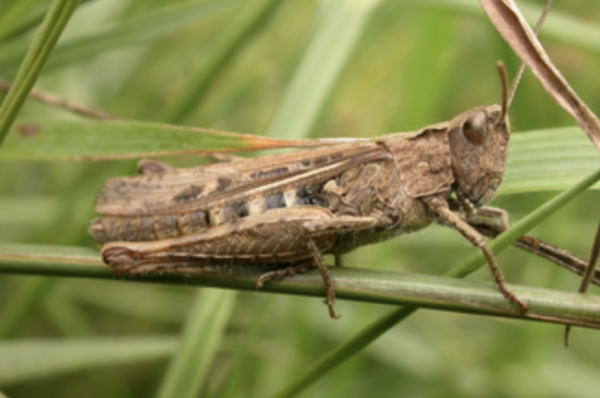Grasshoppers probably date back to more than 250 million years ago, making them one of the earliest herbivorous insects that are still alive today. North America is home to about 600 species while there are more than 10,000 species of grasshoppers worldwide. With their long hind legs, robust body and short thread-like antennae, grasshoppers are easily noticeable from other insects. The closest cousins of grasshoppers are crickets and katydids. Now before we deep dive into what do grasshoppers eat in the wild, let’s explore a little bit about these insects.
Facts About Grasshoppers
One of the fascinating features of these insects is their ability to jump above 20 times their body length. They have pretty strong muscles on their hind legs, which help them in propelling high above into the air. In order to communicate with each other, they make use of chirping sounds. Grasshoppers have quite a number of predators including birds, snakes, lizards, and frogs.

Common Field Grasshopper (Chorthippus brunneus). Photo © London Wildlife Trust
They are known to cause significant damage to gardens and defoliate just about anything. Generally, they are winged insects but some species are flightless. The female grasshoppers tend to deposit 20 to 100 eggs in late summer or in fall and in areas like pasture fields, grassy foothills and ditch banks. They have a lifespan of about two to three months. Grasshoppers usually die when either the weather becomes too cold or the food is hard to come by. They mainly occur along dried out marshes or roadside ditches.
Difference Between Grasshoppers and Crickets
Unlike crickets, grasshoppers ‘sing’ by rubbing their hind legs with their wings. This act of producing noise is known as stridulation. On the other hand, crickets sing by rubbing their wings against each other. What’s more, grasshoppers are active in daytime whereas crickets are most active at dusk.
What Plants Do Grasshoppers Eat
Grasshoppers like to devour especially young green plants. They possess chewing mouthparts just like their cousins: crickets. Some of the favorite food items on the menu of these insects are carrots, beans, onions, corn, and lettuce. However, they do not really like eating vegetables like tomatoes and squash.
Thanks to their chewing mouthparts, these tiny critters can consume plant leaves rather easily. No wonder, they are one of the most common pests of cultivated crops.
Since grasshoppers consume extremely broad range of genera of plants, they tend to grow much better than other insects.
The creosote bush grasshopper is the only species that consumes only one plant species, known as creosote bush.
What Do Grasshoppers Eat and Drink
Out of all herbivorous insects, almost 70 percent consume only a few plant species. However, most species of grasshoppers are general feeders. The migratory species thrive in hay fields and weedy grain fields.
In addition to leaves, grasshoppers also feed on stems, flowers, seed heads, and also fruits. Despite the fact they are herbivores, they may sometimes consume dead insects too.
When vegetation is in short supply like in drought conditions, they migrate to cultivated crops. In July and August, grasshoppers mainly feed soybean foliage.
Few species like South American grasshoppers thrive on floating vegetation.
Some species thrive in forests while most of them live in dry open habitats having plenty of vegetation.
Sources & Further Reading:
Davidowitz, Goggy. “Grasshoppers“. Arizona-Sonora Desert Museum.
“Grasshoppers“. Purdue University.
Flint, M. L. “Grasshoppers“. University of California Agriculture and Natural Resources.
Hammond, G. . “Acrididae” (On-line), Animal Diversity Web. Accessed June 03, 2021.
“Grasshoppers and Crickets“. Amateur Entomologists’ Society.
Evans. Edward W. and Erin W. Hodgson. “Grasshoppers“. Utah State University.
